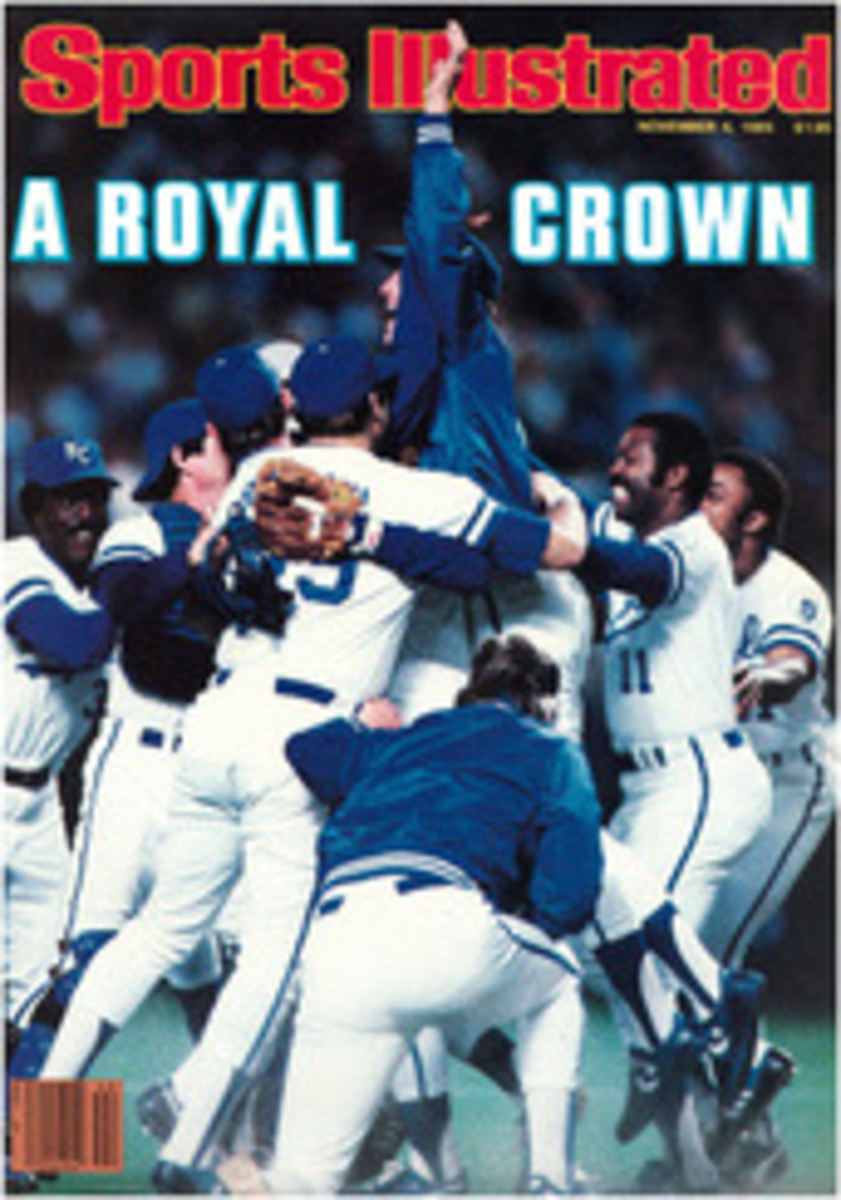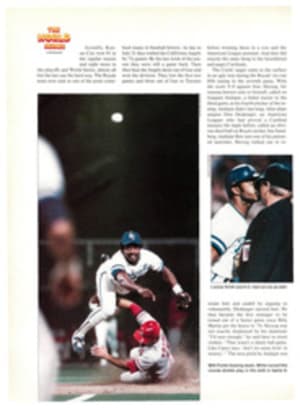
AT MASCOT U'S ANIMAL FAIR ALL THE BIRDS AND BEASTS ARE THERE TO LEARN
Steely-eyed, sternly handsome coach Jeff Davis is a menacing presence on the practice field—until he opens his mouth. Then you wonder if Richard Simmons has had a makeover. Beneath a pitiless midmorning sun last August at Virginia Tech in Blacksburg, Davis's players slouched toward the end of two-a-days, perspiring rivers under their gear. Concern creased Davis's face. Fatigue errors and mental lapses had abounded. Football season loomed a scant two weeks away. Finally he erupted with all the dreadful vehemence of a Broadway choreographer:
"Zippy the Kangaroo, are you alive? Then would you please keep your character going? Northwestern Wildcat, you've got a beautiful tail—now shake it! I want ceaseless tail movement! There, much better! Now we're working."
Davis, as you may have begun to surmise, is not a football coach, nor is this a vignette from anyone's football training camp. We are, rather, eavesdropping on "the bus game," a character-development drill at Mascot University, a five-day cram course in mascotry conducted several times each summer by the Universal Cheerleaders Association.
"Being a mascot is more than a game," says Davis, who's written the book on mascoting—literally. It's entitled Center Stage and Under Cover. "Mascots are evolving. We're seeing more and more elaborate costumes, down to the high school and even junior high levels. It's getting to be a sophisticated, highly trained avocation."
Befitting an enterprise of such depth and nuance, Mascot U's course load includes lessons on everything from emoting properly in costume and walking in character—"If you're a bear, you must move with the lumbering traits of a bear"—to personalized autograph-design counseling and tips on how to get along with college administrators.
"We were delighted to get Jeff," says UCA's effervescent vice-president, Kris Shepherd, once head cheerleader at Arkansas. (She won't say when. She will say it's impolite to ask.) "I think he's just the best there is." Though Davis, 24, longs to be an actor, Shepherd talked him out of a summer's auditioning and drama lessons in Los Angeles to come and teach mascots.
Davis commands great respect in mascot circles. In camp, he had a cast on his left wrist, which he'd fractured last summer in the line of duty. During home games with the Southern League (AA baseball) Memphis Chicks, Davis—the Chick—routinely "hatched" and then flipped from the top of a 10-foot egg. In one game, though, he "went over," cracking his wrist.
As you can see, life has not been all feathered suits and bus rides with cheerleaders for Jeff Davis, maestro of mascots. A decorated high school fullback, he dropped football to pursue cheerleading at Southern Mississippi. Think that didn't take guts? Davis's father is a farmer and former standout jock—named Billy Joe. "He had some problems with the cheerleading," recalls Davis. To his acute disappointment (the son's, not the father's), Jeff didn't quite have what it took to make cheerleader that year. When offered the mascot job, he hurriedly accepted. You know, anything to be close to the squad.
And for four years he never surrendered it. Davis actually received his diploma in his Golden Eagle costume, and when he graduated, popular sentiment called for him to remain on a permanent basis.
Instead, he found work in Louisiana as a pelican. As Seymore D. Fair, he traveled the world plugging the 1984 New Orleans World's Fair. He stumped Europe (where he was thrown out of the Louvre) and made a big splash at the '84 GOP convention in Dallas. He rubbed, er, limbs with numerous chiefs of state and once, at the White House, danced with the wives of Russian diplomats. Billy Joe began to come around.
One Mascot U course outline goal was "incorporating the mascot into spirit activities for optimum results." Although outnumbered by cheerleaders and dance-team members 1,200 to 52, the mascots maintained a high profile. Every afternoon they waded amiably, and disruptively, through the cheerleaders' squad formations, mingling, exacting hugs, always fine-tuning their buffoonery.
Not everyone loved the mascots. Robert (Kong) Kyle, a camp manager, leveled this accusation: "Being a mascot—it's just a license to goose. Give me a costume and I'll grab every cheerleader I see. I swear, those guys have it great."
On the whole, they were adored. "They're really a lot of fun," said Shepherd on the second morning—but there was mild apprehension in her voice. As she spoke, dozens of mascots streamed from Pritchard Hall like Marines hitting the beach and went about scavenging the campus.
"Prop workshop," said Shepherd. Frowning, she watched as they entered buildings and made off with wastebaskets, dustpans, cardboard boxes, brooms, a near-whole roll of toilet paper, a loaf of white bread.
One student mascot struggled to uproot a newspaper vending machine. "No!" boomed Shepherd, as if at a bad dog. Chastened, the young man slunk away and made do with a tree limb.
"We had a problem with the prop workshop last week at Memphis State," explained the vice-president. Consumed with zeal for their lessons, the mascots had swooped down on a backyard adjacent to the campus, ravenous for props. Among the miscellany they removed was a grill, a sack of charcoal briquettes and a child's bicycle—all the property of Memphis State's housing director, who had arranged their accommodations.
"He was pretty good about it, after we returned his things and apologized," said Shepherd. Also taken, however, was the ladder of a painter who was on the roof at the time. He was marooned half an hour.
It was show-and-tell time back in class. Mascots compared props and discussed possible uses for them. "I think I'll use this box to hide in," said one. "The team I root for stinks."
Another held up a section of cardboard. "I could make an eye chart for lousy officials."
"You could use the broom as a cane and imitate a blind man, for bad calls," offered Brad Klinck, the Pennsylvania Quaker.
"Or," added a colleague, "make like you're sweeping up after the other team's mascot, you know, embarrass him that way."
Whoa, Nelly! Time out! Hold it right there! Deliberately and in somber tones, Davis explained why suggestions of mascot excrement, however remote, were absolutely off limits.
"As a mascot, you're trying to create a make-believe character," he said. "You live in a world where there's no sex or alcohol or vice or anything like that." Nothing a mascot does, he went on, should remind spectators of the banal travails of their own daily lives. "Nothing that's not part of our make-believe world."
This was the sovereign tenet of Mascot U's curriculum, a recurring theme throughout Davis's next lecture, "Mascot Don'ts." The cardinal don'ts, then:
•No obscene gestures. "Everything you do is going to reflect on your school," warned Davis. "Whatever you do in the costume follows you. People will stop coming to games. Alumni will stop contributing. And is there any faster way than that to ruin your rapport with the administration?"
Yes—stealing its grills. But Davis's point was well taken.
"And don't encourage chants like 'Bull——! Bull——!' "
"What if we think the refs have made a bull——call?" asked Jon Mihlik, Seton Hall's Mr. Parrot.
"You can think it," said Davis, "but your character had better not show it. Reach into your prop bag. Start another chant. It's a great way to score brownie points."
•Don't talk in costume. "When you talk, you're ruining the make-believe character you're trying to create." Under Davis's critical eye, mascots were schooled in pantomime and taught to convey emotions. Mum was the word—"unless there's a real emergency, and you need to get out of the suit."
That isn't such a farfetched scenario, as Laurie McFarlin can attest. In costume as the Northeastern (Mass.) Ms. Husky, she is gray-furred, doe-eyed, eminently embraceable. Maybe too much so. At a Husky hockey game three years ago, McFarlin was embraced by hooligans, carried from Boston University's arena and stuffed into a car trunk. She has also been suspended by her paws from the Matthews Arena balcony, 25 feet in the air, and once, at another hockey game, "some cad" punched her in the snout.
"All the crowd saw was a life-size stuffed animal getting knocked on its [haunches]," recalls McFarlin. "They loved it." Inside the costume, though, her nose was broken and gushed blood.
"Sometimes people forget there's a person in there. I've found it's a good idea to talk to security guards before games just to let them know I do break."
•Never appear in partial costume. "It ruins the magic spell," says Davis. "Without the audience participating in the make-believe, you're just a gal or a guy in a suit"—no better than those shopping-mall Santas who take their beards off in full view of children. At Blacksburg, it was announced grimly, mascots caught in half costume would suffer an automatic one-ribbon deduction at daily evaluations. This was a superb deterrent.
•Don't store your suit in a damp environment. By the third day, to enter the room where costumes were stored was to know how a Sioux tepee smelled just before spring thaw. "You get used to it," say the mascots.
The preeminent Mascot Do: Always stay in character. And how better to grasp and live this than by observing the masters and emulating them? So one afternoon the mascots studied Looney Tunes cartoons.
"Bugs Bunny, Daffy Duck, Sylvester the Cat—they live in that make-believe world that we're trying to create," said coach Davis. "Watch Sylvester on the ledge here...see how he's sneaking up on Tweety? Try that on the sidelines."
But it was a sultry afternoon in Virginia. Cartoons failed to hold everyone's attention. Some mascots gazed out the windows to where a dance team drilled. Others napped. Davis continued his commentary. "Look at Wile E. Coyote's head here, the side-to-side motion. Make a note of that. Oh, watch this, this is a good one...."
Suddenly spying the slumberers, Davis spoke curtly. "It looks like a few of us should try sleeping at night."
One of the few, Virginia Tech's own Hokie Bird, piped up. "I disagree, Jeff. We live in a make-believe world. We don't need sleep."
This brought laughter. Davis darkened but lectured on. There was, after all, much ground to be covered. And football season was less than two weeks away.
TWO ILLUSTRATIONS
KEN WESTPHAL

